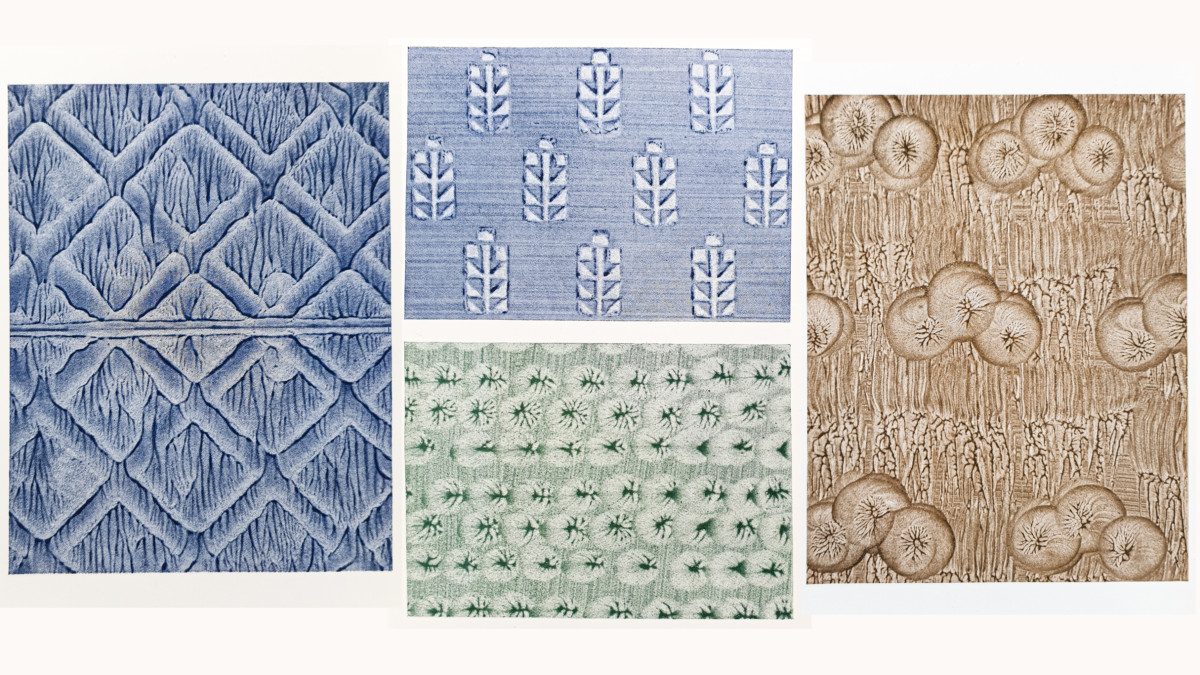“Starch Marbling” as Described in Het Drukkers Jaarboek 1911
Among other exciting things, I found in the last volume of the Dutch Printers Yearbook from 1911, was an article by Reinier Willem Petrus de Vries Jr. about a technique that “recently” attracted the attention of some bookbinders — starch marbling.
The first half of the article doesn’t say a word about this method. Only after we are shown some samples there starts a description of the technique.
I will quote the second part of the article below. Please keep in mind that it was Google translated from Dutch and then edited by me.
However, the cumbersome nature of the arrangements is undoubtedly the reason why few binders are looking for a new method of decoration in the marble technique. And it is also certain that in recent times some binders in our country and abroad have simplified these methods. One of these simplifications was already in use with some binders in the 18th century is known as “starch marbling1..”
That a large variety of beautiful papers can be made with this method is proven by the many samples provided by the former Haarlem binder Joh. B. Smits (currently a chief teacher for the graphic subjects at the Zurich School of Applied Arts.) You can see the samples provided by him above.
Let’s start with stating that it would be better to disconnect the tag of ’marbling’ that is wrongly attached to the method. Even while one may find some visual similarities with veined marbling, we would rather look at it as a completely separate process if the starch marbling that can generate beautiful color combinations and peculiar motifs.
The technique itself is relatively straightforward, and only the greater or lesser skill and ingenuity determine the result.
It is necessary to start with a good hard underlay, a lithographic stone, a glass plate, a zinc plate, even a board covered with tarpaulin can serve. The goal is for the surface to be very flat. Here a sheet of paper is accurately flattened and covered with the pre-colored starch paste.
The starch paste must be sifted through a nettle cloth after cooling to remove all imperfections. After that it is mixed with watercolor or with the so-called ‘Halter marbling paint’2 that can be obtained in every shop selling bookbinder materials.
To keep the color better after drying some double chromic acid potash is often added to the starch, which, however, gives it a slightly yellowish tint.
When the colored starch is spread over the paper with a rather broad brush, the decoration can begin. During the process, many tools are used. Often very primitive and most of own invention.
Continue to draw lines in the transparent starch layer. The simplest decoration can thus already be achieved using a steel comb, as the wood painters use. Draw it over the paper in straight or curved lines, dragging slowly. The higher or lesser thickness of the starch now again causes a different result. Pressing a fingertip, a small sponge, a figure cut into leather or rubber at regular intervals also allows creating lovely patterns. That’s what makes unique each designer’s work.
If the paper is designated for use as endleaves, it is peculiar to make the pattern in such a way that it runs from the center line, which is pinched, to the right and left.
Then the still wet paper is folded in half, and the decoration is thus transferred. The pattern appears opposite on both halves when the paper is opened.
It is self-evident, however, that this simple technique must be used wisely. Especially because it is known that wiping and pressing in the wet starch layer very easily gives creates a relief, which should be avoided as a method of surface decoration in book art. With some practice, however, it is possible for the bookbinder to make lovely papers with a leather color. There is also something animating about it; it exerts taste and fantasy.
But unfortunately, we don’t know if it will last. In Germany, it is starting to become fashionable and Frau Professor …. Frau Baumeister …. are making ‘Kleistermarmor’ that they sell at reasonable prices. To satisfy the numerous requests yet another Berlin factory adopts this simple and nice technique for their production.
At least we can be sure that the technique of making paste paper didn’t die out in the early 20th century. And it is quite enticing and educating to see how it all began and what was the initial response to this new method of decoration.
We have recently digitized Het drukkers jaarboek 1911 (The Printer’s Yearbook, 1911) and it is available to our patrons on Patreon or on our Issuu page.
Please Support us on Patreon!
 The minimum level of contribution is only $1 per month.
The minimum level of contribution is only $1 per month.
Moreover, starting with the pledge level of $3, you will get a digitized vintage book about bookbinding, book history, or book arts each month from us!
These pledges help iBookBinding to continue its work and bring more information about bookbinding and book arts to you!
- Or something like that—”stijfsel marmer” in the original Dutch text
- Supposedly that’s a reference to Josef Halfer’s paints. Josef Halfer (1846-1916) was a bookbinder and marbler from Budapest, Hungary






